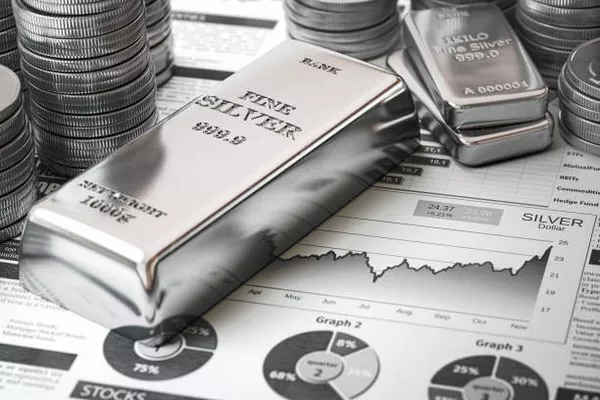Silver, often referred to as the “poor man’s gold,” has long been a sought-after precious metal with a rich history of use in various industries and as a store of value. Investors closely monitor silver prices, and predicting its future trajectory is of paramount importance for those looking to capitalize on market trends. In this article, we will delve into the factors influencing silver prices and attempt to shed light on when silver is expected to rise.
Current Market Overview
As of the latest market data, silver prices have experienced some volatility in recent months. The metal, known for its dual role as an industrial commodity and a precious metal, is influenced by a myriad of factors, making accurate predictions challenging. However, a comprehensive analysis of key indicators and market trends can provide insights into when silver is likely to experience an upward movement.
Factors Affecting Silver Prices
Industrial Demand:
Silver’s extensive use in various industrial applications, including electronics, solar panels, and medical devices, significantly influences its price. As global industries continue to recover from the impacts of the COVID-19 pandemic, increased industrial demand for silver is anticipated. The growth in green technologies, particularly the push for renewable energy sources, further boosts silver’s role in manufacturing solar panels and electric vehicle components.
Investor Sentiment:
The sentiment of investors plays a pivotal role in the precious metals market. Silver, often considered a safe-haven asset like gold, tends to attract investors during times of economic uncertainty. Geopolitical tensions, inflation fears, and concerns about currency devaluation can drive investors towards precious metals, influencing the demand for silver. Monitoring global economic conditions and geopolitical developments is crucial for gauging investor sentiment and its potential impact on silver prices.
Inflation Hedge:
Silver has historically served as a hedge against inflation. When inflationary pressures rise, investors seek assets that retain value over time. Precious metals, including silver, are viewed as a store of value under such circumstances. Central banks’ monetary policies, interest rates, and inflation rates are critical factors to consider when assessing the potential for silver prices to rise in an inflationary environment.
Mining Production and Supply:
The supply-side dynamics of silver also play a crucial role in determining its future price movements. Mining production, geopolitical factors affecting mining regions, and disruptions in the supply chain can impact the availability of silver. If production struggles to keep pace with demand, it can create a supply deficit, potentially driving prices higher.
Currency Strength:
The strength of the U.S. dollar often has an inverse relationship with precious metal prices, including silver. When the dollar weakens, silver prices tend to rise, as it becomes more affordable for investors holding other currencies. Monitoring currency trends and developments in major economies, particularly the United States, is essential for predicting silver price movements.
Projections for Silver Price Movement
Considering the aforementioned factors, several indicators suggest that silver may experience a notable uptrend in the coming months and years.
Growing Industrial Demand:
With the global push towards sustainability and green technologies, the demand for silver in industrial applications is expected to rise. The increasing adoption of solar energy, electric vehicles, and advanced electronics will likely drive industrial demand for silver, providing a fundamental support for higher prices.
Inflationary Pressures:
As central banks implement accommodative monetary policies in response to economic challenges, concerns about inflation are on the rise. Investors seeking protection against inflationary risks may turn to precious metals, benefiting silver prices as a result.
Renewed Investor Interest:
The resurgence of interest in precious metals as safe-haven assets during periods of economic uncertainty could attract investors to silver. As geopolitical tensions persist and economic uncertainties loom, silver may experience increased investor demand, contributing to a potential price rally.
Supply Constraints:
Mining challenges, geopolitical tensions in major mining regions, and potential disruptions in the supply chain may impact the availability of silver. If these factors lead to a supply deficit, it could put upward pressure on prices, creating a favorable environment for silver investors.
Weakening U.S. Dollar:
The U.S. dollar’s strength has historically had an inverse relationship with silver prices. If the dollar weakens due to economic factors or policy decisions, silver prices may benefit from increased affordability in other currencies, potentially leading to an upward trend.
See Also Will Silver Ever Increase In Value
Conclusion
While predicting the exact timing and magnitude of silver price movements is inherently uncertain, a comprehensive analysis of the factors influencing the market provides valuable insights. As we navigate the complexities of global economic conditions, industrial demand, investor sentiment, and supply dynamics, it becomes evident that silver holds the potential for a future price rise.
Investors and market participants should remain vigilant, staying informed about key indicators and monitoring developments that may impact silver prices. Whether driven by increased industrial demand, inflationary pressures, renewed investor interest, or supply constraints, the factors converging to influence silver prices suggest a cautiously optimistic outlook for those considering silver as part of their investment portfolio. As always, conducting thorough research and consulting with financial experts are essential steps for making informed investment decisions in the dynamic precious metals market.


